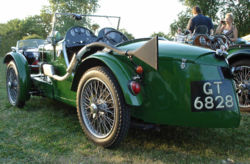
MG C-Type
Encyclopedia

MG (car)
The MG Car Company is a former British sports car manufacturer founded in the 1920s by Cecil Kimber. Best known for its two-seat open sports cars, MG also produced saloons and coupés....
Car company from 1931 to 1932. It was designed for competition use and based on the M-Type Midget
MG M-type
The MG M-type was produced by the MG Car company from April 1929 to 1932. It was sometimes referred to as the 8/33. Launched at the 1928 London Motor Show when the sales of the larger MG saloons was faultering because of the economic climate, the small car brought MG ownership to a new sector of...
. A special car, EX120 had been developed from the M-Type for George Eyston
George Eyston
- References :*...
to make an attempt on the 750 cc class 24 hour record at Autodrome de Montlhéry
Autodrome de Montlhéry
Autodrome de Montlhéry is an automobile racetrack, officially called L’autodrome de Linas-Montlhéry, located across the towns of Linas Bruyères-le-Châtel and Ollainville, outside Paris in the southside....
in France. The attempt was successful and a series of replica cars were made which became the C-Type.
The car used a tuned short stroke (73 mm) version of the bevel gear driven overhead camshaft
Overhead camshaft
Overhead cam valvetrain configurations place the engine camshaft within the cylinder heads, above the combustion chambers, and drive the valves or lifters in a more direct manner compared to overhead valves and pushrods...
engine from the 1928 Morris Minor
Morris Motor Company
The Morris Motor Company was a British car manufacturing company. After the incorporation of the company into larger corporations, the Morris name remained in use as a marque until 1984 when British Leyland's Austin Rover Group decided to concentrate on the more popular Austin marque...
and Wolseley
Wolseley Motor Company
The Wolseley Motor Company was a British automobile manufacturer founded in 1901. After 1935 it was incorporated into larger companies but the Wolseley name remained as an upmarket marque until 1975.-History:...
10 with a single SU carburettor and a new crankshaft producing 44 bhp at 6400 rpm. It could from 1932 be had with the crossflow head to be seen later on the MG J-type and a Powerplus supercharger
Powerplus supercharger
The Powerplus was a design of supercharger used to boost the performance of car engines in the 1930s. It is a mechanically-driven positive displacement pump, operating on the sliding-vane principle.- MG cars :...
version was also available with 52.4 bhp at 6500 rpm. Drive was to the rear wheels through a four speed non-synchromesh gearbox. The chassis was new and took the form of a ladder frame with tubular cross members and passed under the rear axle. The suspension used half elliptic springs and Hartford friction shock absorbers with rigid front and rear axles and centre lock wire wheels. The car had a wheelbase of 81 inches (2057 mm) and a track of 42 inches (1067 mm).
The body, which had no doors, was metal over an ash frame and had a pointed tail which held the spare wheel and cycle type front wings. Later cars had a more conventional rear with a slab type fuel tank. The exhaust pipe was routed outside the car and finished with a spectacular fishtail. The record breaking cars had a streamlined cowl over the radiator but this was not usually fitted to later cars as it could cause overheating unless high speeds were maintained.
The standard car initially cost £295 or £345 for the supercharged version rising to £490 and £575 by the end of production.
As well as the Montlhéry record, C-Types were used in many other competition events including a works team of fourteen cars entered in the 1931 Double Twelve event at Brooklands
Brooklands
Brooklands was a motor racing circuit and aerodrome built near Weybridge in Surrey, England. It opened in 1907, and was the world's first purpose-built motorsport venue, as well as one of Britain's first airfields...
where they took the first five places.

